How to Control Aphids and Mealybugs
Plants and pests go hand in hand. They are by no means a match made in heaven, but chances are that if you have plants, they’ll get some sort of infestation at one time or another. This is all about aphids and mealybugs, identifying them, and controlling methods.
So many different plant pests are specific to certain plants and/or regions. I will cover the two common ones I’ve seen most often infest, as houseplants and in the garden.
If your plants have aphids: How To Get Rid Of Aphids Naturally. If your plants have mealybugs: How To Get Rid Of Mealybugs On Plants.
What Do These Plant Pests Do to Plants?
Both aphids and mealybugs are soft-bodied scale insects. They slowly suck the sap out of plant parts which over time weakens them, stunts the growth, and deforms the flower.
You can liken sap in plants to blood in animals. The sap contains sugar which the insects love but can’t fully ingest, and it oozes out on the plant as a sticky substance. This is why an infested plant will have sticky leaves.
You might also notice a black mold-like substance appearing on the leaves. This is a fungus that grows on the excreted sugar. This sooty mold can ultimately damage the plant also.
Ants flock to an infested plant not because they want to attack it but because they’re after that sweet sugar too. Don’t worry; the ants don’t harm the plant and will leave after the aphids are gone.
Aphid infestations and mealybug infestations can spread fast and furious. It’s best to get a method of control in place as soon as you first spot them.
How to Identify Aphids & Mealybugs
Aphids
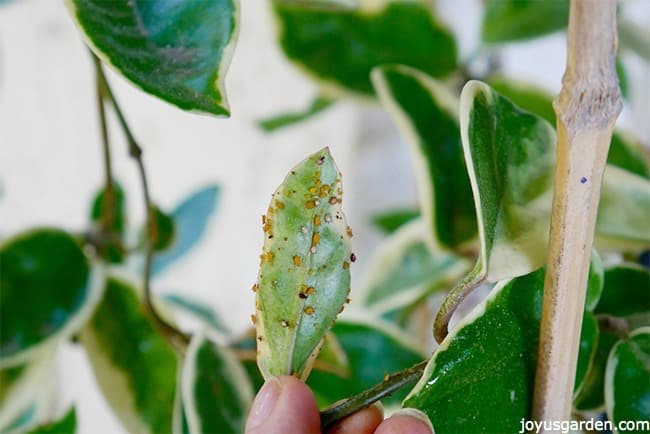
Different color aphids on the underside of my variegated hoya leaf.
I’m starting with aphids because they seem to appear out of nowhere in the spring. They multiply like crazy and can easily become a problem. One day, you can see five of them, and five days later, there seem to be hundreds.
Aphids are found in various colors, including green, orange, black, brown, white, gray, yellow, red, and even pinkish. They are easily visible on a plant, especially if they’re a color other than green.
They’re tiny but still visible to the eye. A magnifying glass is needed to see details of their bodies.
Without getting technical, I’ll give a quick description. They’re oblong in shape and wider at the base. Some have wings, and some are wingless. They have antennae and three pairs of long legs.
Aphids start to appear in late winter/early spring, so keep an eye out for them during this time.
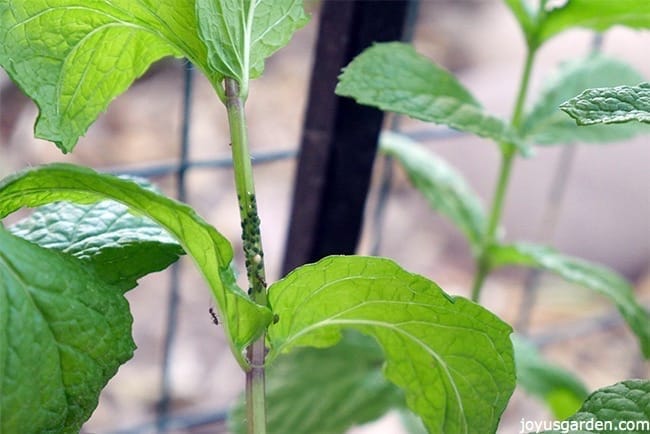
Aphids & ants go hand in hand. Here ants are hanging out with aphids on my Mojito Mint. They’re after the sweet, sugary substance secreted by the aphids.
At my previous home, my variegated hoya topiary (growing outdoors) had orange, grey, and black aphids, my mint had green aphids, and my grapefruit tree had black aphids. And the plants all were within feet of each other!
Here at my new home, my Hoya pubicalyx hanging in the dining room is currently infested with orange aphids. I’m having a struggle getting control of the situation with just water and vinegar, so this is what prompted me to update this post.
Heads Up: Aphids love fresh, new growth and tender stems. Like most plant pests, they like to hang out and feast on the undersides of the leaves, where it’s a bit more protected.
Mealybugs
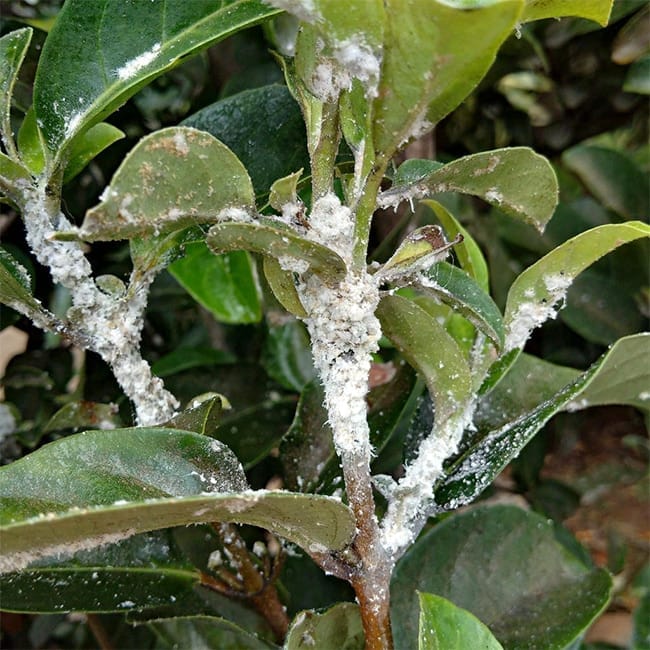
A bad infestation of mealybugs.
Mealybugs move slower than aphids. They can be found on every part of the plant, even the roots. They especially love to hang out in the nodes and are a common pest of houseplants, especially succulents.
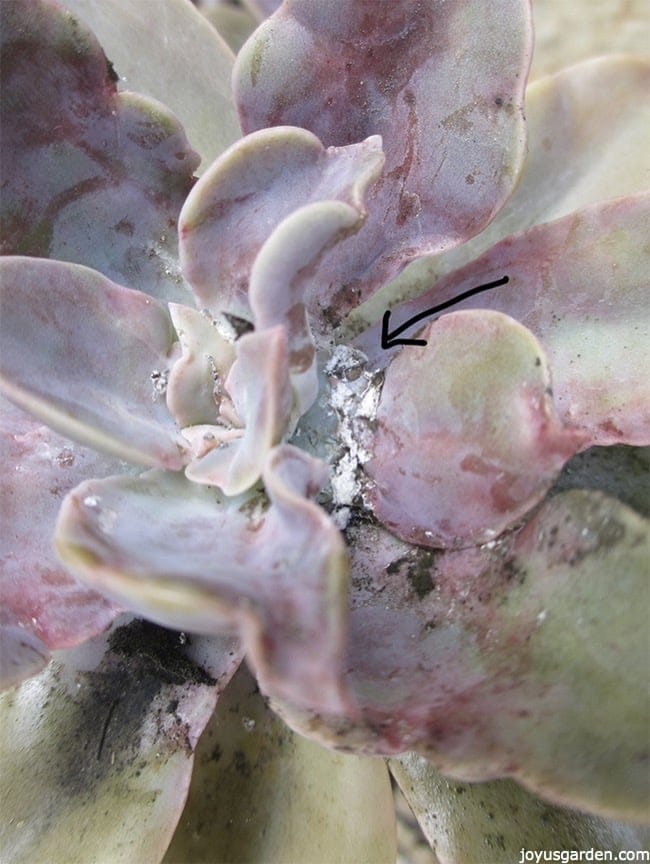
Mealybugs love succulents. Here, you can see how they gather in the nodes. The black spots on the leaves are that sooty mold.
If you see something which looks like small dots of white cotton on your plants, that’s a sign it’s mealybugs. The white cottony substance is the trail that they leave behind.
Mealybugs are teeny tiny and yellowish, but the white stuff gives them away. Whiteflies also leave behind a white residue, but it looks different, and you can actually see them moving around. Whereas with mealybugs, you can’t.
Growing up in New England, we had a 3′ Jade Plant growing in our greenhouse. It would get mealybugs every year, and I would dab them off with a cotton swab dipped in rubbing alcohol and water. I must’ve really loved that plant!
Head’s Up: Mealybugs love to hang out in the nodes (where the leaf meets the stem) and in the crevices of the newer growth.
How To Control Aphids and Mealybugs
As a general rule, you get control of aphids and mealybugs using the same methods. I’ve found that a firm spray with water works best for a mild infestation of aphids, whereas it’s cotton swabs and rubbing alcohol for a mild mealybugs infestation.
1.) Release predators in your garden.
Encourage ladybugs into your garden as a method of control. Lacewings also devour soft-bodied insects like aphids and mealybugs much faster than ladybugs. This obviously isn’t a viable solution for your houseplants.
I worked at a nursery in Berkeley that used to sell ladybugs but stopped. Half the batch would be dead upon opening, and they felt that was cruel. I agree—cute little lady beetles!
Lacewings are very effective and can be bought as larvae. You can look into buying lacewing eggs here.
2.) Spray with water using the garden hose, kitchen, or bath spray.
This is the method I fall back on, especially with aphids in the garden. You want to gently blast off (no fire hose action here, please) the pests and their eggs.
If you don’t have access to a hose outdoors, the spray in your kitchen or bathroom will be suitable for your houseplants.
3.) Insect killer sprays.
I don’t use chemicals, so these are considered “natural controls.” The most common include horticultural oil, insecticidal soap, and neem oil. Most plants can be sprayed with these but check 1st.
There’s plenty of research on these products, so see which one would be best for you, your plants, and whatever pest you’re controlling. You can buy them ready to spray or as a concentrate that you mix up to use in your own sprayer.
Here are some options: insecticidal soap ready to use, insecticidal soap concentrate, horticultural oil ready to use, horticultural oil concentrate, neem oil ready to spray, and neem oil concentrate.
I’ve never used this one, but it’s listed as a houseplant & garden insect killer. Upon updating this post, I bought insecticidal super soap to get rid of the orange aphids on my hoya. I’ll let you know how effective it is as soon as I’ve used it with the recommended 2-3 doses. (Update: It worked after two applications!).
There are many “safer” controls on the market, so you’re sure to find one that works best for you.
4.) Make homemade spray recipes.
There are many homemade recipes out there to combat plant pests. Here’s the way I’ve always made a soap/oil spray: Mix 1 tablespoon mild dish soap or Dr. Bronner’s, 1 tablespoon vegetable oil, and 1 cup water. This works on mild infestations.
Here’s what I’ve used to get rid of mealybugs: Mix rubbing alcohol with water. You can either dab it on the mealybugs with a cotton swab (1 part alcohol to 1 part water) or spray it on (1 part alcohol to 6 parts water). If you spray it, try not to soak the whole plant. Aim it at the mealybugs. I use the dabbing method because it’s easier to target the pests.
For aphids on my houseplants, I take them to the sink and give them a gentle blast with water. I let the plant dry completely. I then spray thoroughly with a mixture of approximately 1/4 vinegar (I routinely use white but have used apple cider also) and 3/4 water. Repeat again in 1-week intervals 1-2 more times as needed.
Easy does it with the vinegar – using a concentration of too much or spraying too often can burn the foliage. And, I wouldn’t use it on seedlings for that very reason.
Rodale’s, a source for living naturally that I’ve known about and respected for a long time, has a recipe for a natural pest spray with garlic, onion, and cayenne pepper.
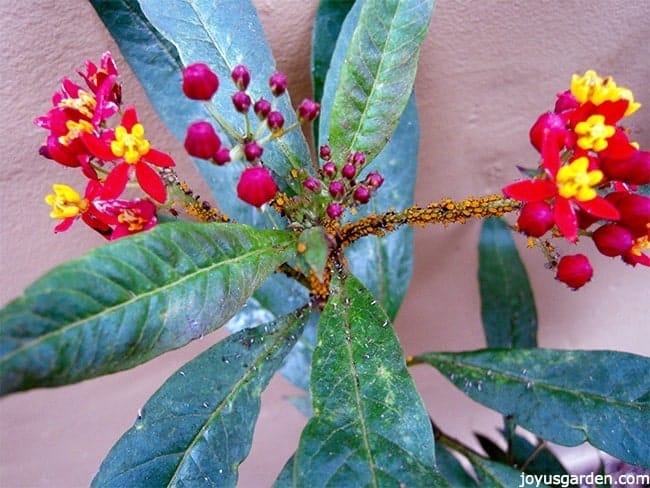
Orange aphids covering the stems of Butterfly Weed. There are certain plants that aphids just love, and this is one of them.
Be sure to check out our other plant pest guides: Spider Mites & Whiteflies, Scale & Thrips, and Fungus Gnats & Root Mealybugs.
Good Things To Know About Controlling Aphids and Mealybugs
1) Aphids especially love the fresh, newer growth. Mealybugs love to hang out in the nodes and crevices. Both can be found on the undersides of the leaves so be sure to check there.
2) Both have soft bodies so they’re easy to control if caught early on.
3) Which leads me to: control these pests as soon as you see them. They lay eggs like crazy so the population increases fast. Once the infestation gets bad, they’re hard to get rid of. Your plant may not recover.
3) If you see ants on the infested plants, they’re after the sugary residue (often called honeydew) left behind by the aphids and mealybugs. Once the insects are gone, the ants will be too.
4) The leaves of the plant can get sticky – that’s caused by the sugar secretion. You might see a black residue (the fungus) appear. You’ll want to get rid of that too.
5) If you choose to spray as your method of control, you’ll need to repeat. If you purchase, be sure to follow the instructions on the bottle as to how often to apply.
A homemade spray you can repeat every 7 days. It might take 3-4 rounds to control the pests.
6) It’s very, very, very important to spray the undersides of the leaves thoroughly. That’s where these pests hang out.
7) Make sure the plant isn’t stressed (ie bone dry) before spraying. And, don’t spray in the hot sun.
8) Be sure to inspect any new plants you bring home to make sure they’re not carrying any pests.
9) The same goes for plants that have spent the summer outdoors. Check them for pests before bringing them inside for the colder months.
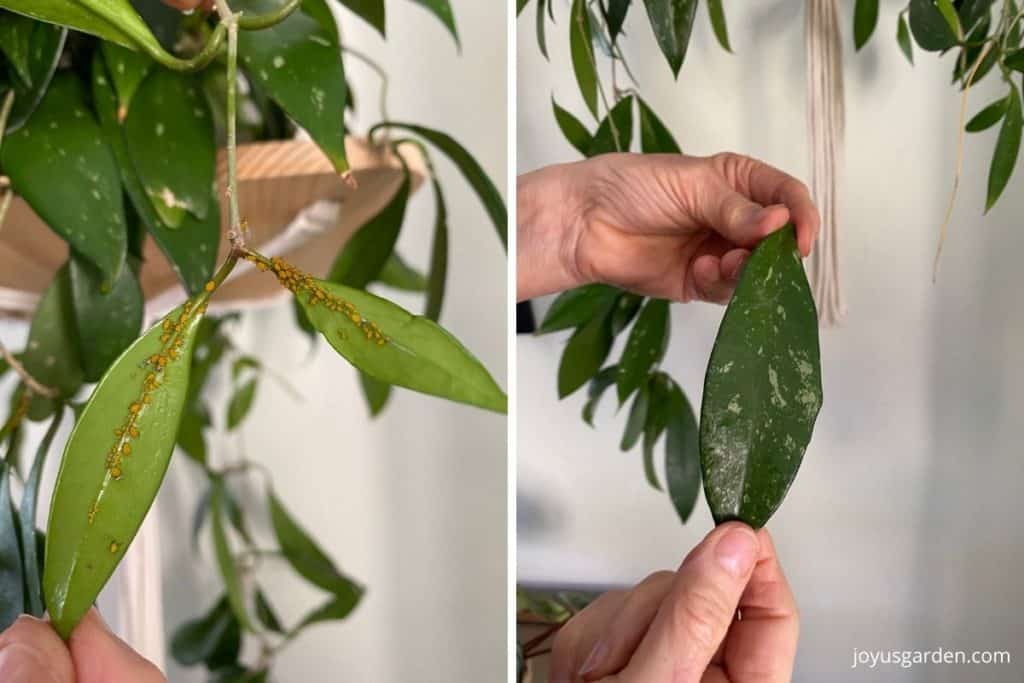
FAQs About Aphids and Mealybugs
They are different, but both are sucking, soft-bodied scale insects.
Not that I know of. Both are much more interested in sucking the juice out of plants rather than eating each other.
There are quite a few predators that will eat them. The most commonly known are ladybugs & lacewings.
There are many available for you to buy, depending on what’s best for you. I always recommend one that is geared to organic gardening because you don’t want to harm the other creatures in your garden or spray chemicals in your house.
If the infestation isn’t too bad, you can mix up a homemade spray with a solution of 1:1 rubbing alcohol to water.
Yes, it does. The acetic nature of vinegar basically fries them.
You’ll be able to get rid of them one year, but new ones may make an appearance the next year. As far as permanently goes, the answer is maybe.
There are certain houseplants and plants in the garden that they love. They’ll often show up again, like with my hoya.
It’s best to spring into action as soon as you see them because a few can turn into an infestation fast.
They can hitchhike in on other plants or on some part of your body. They can also come in open doors or windows.
Hopefully, your plants never get aphids or mealybugs, but if they do, you can now identify them and take action.
Happy (pest-free) gardening,

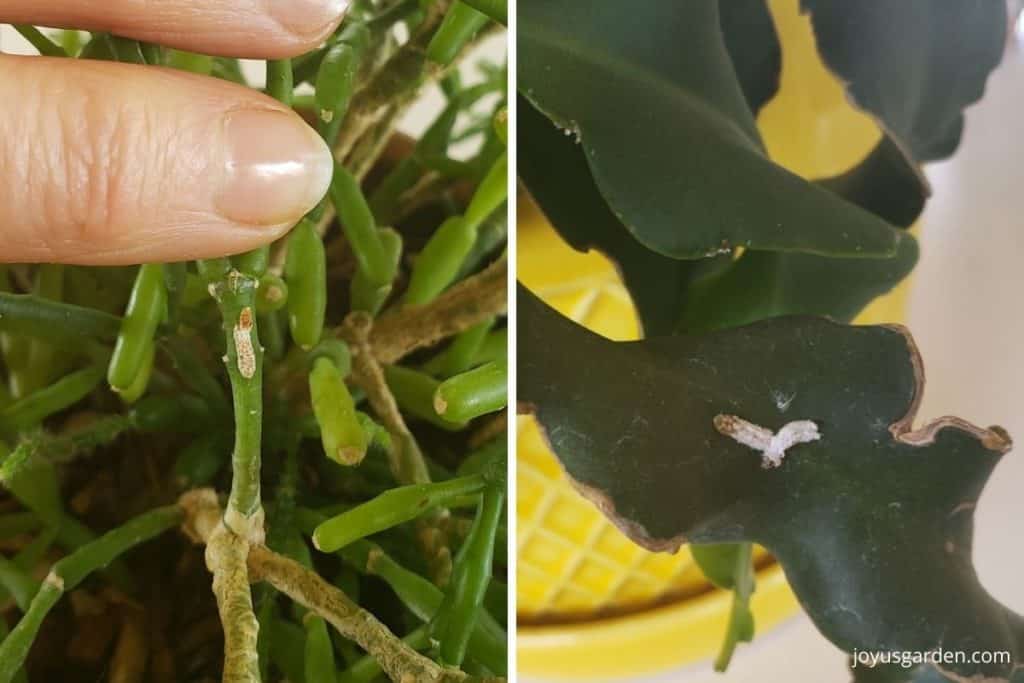


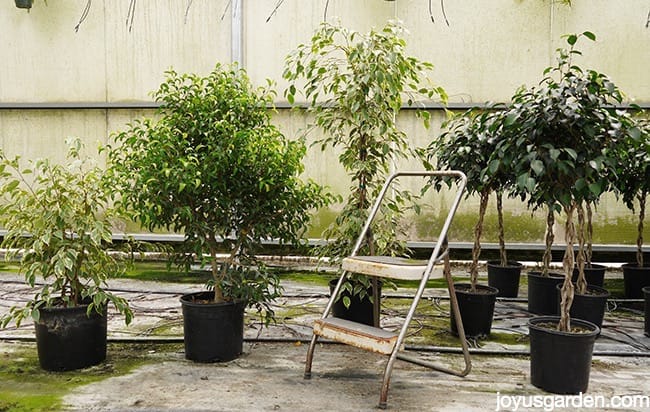
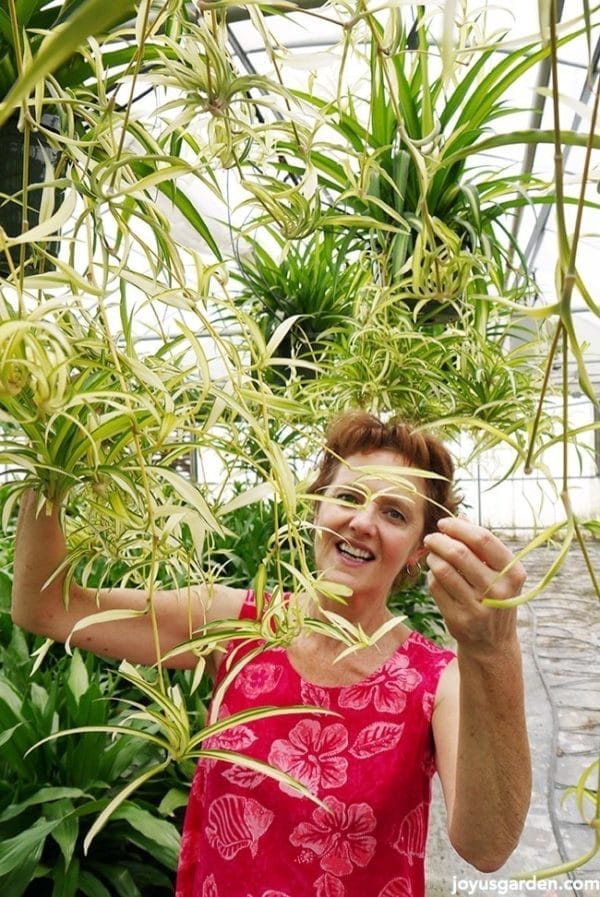
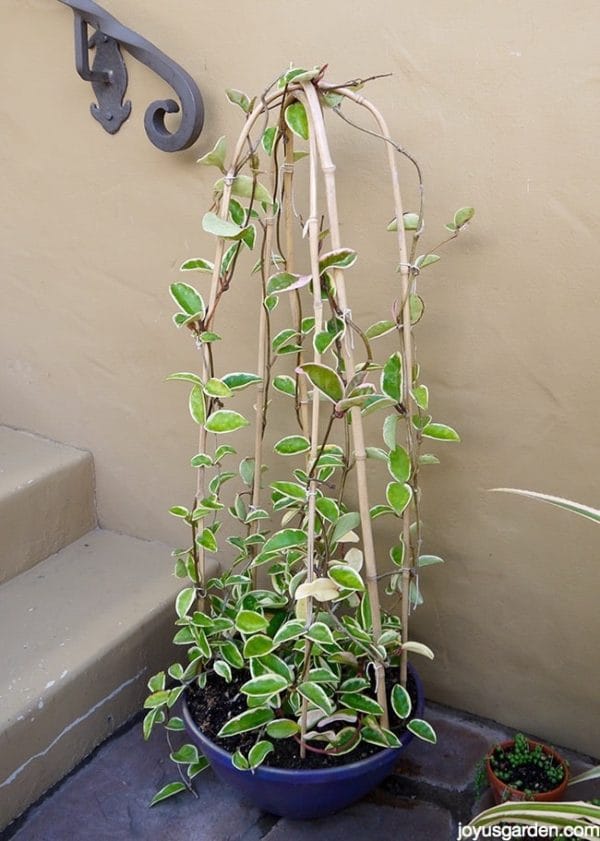

If the mealy bugs are in the root how do you get rid of them there?
Hi Sylvia – I’ll be touching on that in a video & post soon. I’ve dealt with them a couple of times. Here’s what I did: remove the plant from the pot & shake off as much soil as you can. Put the infested soil in a plastic bag & get rid of it. Dip the roots in warm to hot water (hot enough to kill the mealys but not the roots) with a few drops of mild soap. Repeatedly dip them. Pot the plant into fresh soil. Nell
I like how you conversation, Nell.Thanks alot
Thank you Linda! Nell
Just sprayed my mealybugs with water so they’re gone for now but I’m sure they’ll be back … will try rubbing alcohol next time! Thanks for all the work you put into sharing your expertise 🙂
Hi Jen – As I said, plants & pests go hand in hand so I’m sure you’ll see them again. I’m always happy to share! Nell
Item #3 – you say “need” oil… I think you might mean NEEM ?
Susan – Oh yes, that’s for that! I’m changing it now. At least a few lines down the links go to neem oil. Nell
great informations ….. seems garlic and neem extract will do the work….my potted plants are infected secverly
Hi Nazir – Thank you. I’ve heard that garlic oil works but Have never tried it myself. Thanks for sharing that. Nell
Thanks for this informative post! I caught some mealybugs early on and sprayed the staghorn plant down and then literally just went through, leaf by leaf, and scraped off any little ones I could still see with my fingernail (yes, gross, but the kitchen sink wasn’t strong enough to get many of them apparently).
The fern doesn’t seem to be too badly damaged yet, but I am wondering for future reference how you get rid of the black fungus/residue. Do you just have to remove leaves/sections with that entirely? Or is it something you can spray/wipe off? Or?
You’re welcome Sonja! The black residue is due to the honeydew secretion by the pest. Once you get the pests under control, you can easily wipe off the residue off the leaves with a damp cloth. Nell
Hi Nell,
I sprayed my succulent with neem oil with water( followed the manufactures instructions) but now my succulents have unslightly spots on them. How do I get rid of them ?
Hi Jean – it might be spots from from too much moisture. Once they’re spotted, you can’t from that, you can’t get rid of it. Nell
If you blast them off with the water hose, won’t they just climb back on the plant?
Nick –
They usually don’t. They love the fresh growth that pops out in Spring. If they show up again in summer, I just hose them off again. Nell
Well explained, cautions, precautions tips thanks. Works well.
Thanks Rodney. Precaution is best. Nell
Hello,
I see comments about house plants infestation. But how about outdoors bushes?
I have a tall and old beautiful rhododendron covered with mealybugs and the neighboring holly is covered with them too.
I see the rhododendron has many dead branches inside.
How to get rid of them outdoor?
Elisabeth – Same methods as controlling them indoors (except for removing them manually). You’ll need a good-sized sprayer for those landscape plants. Nell